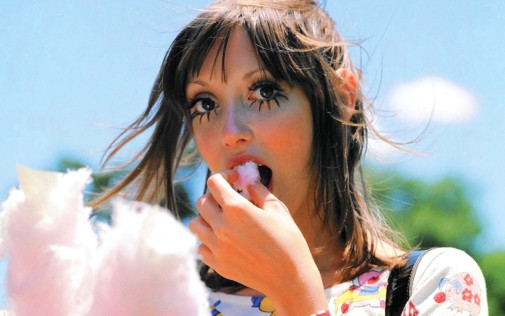
Shelley Duvall is one of a kind. Upon seeing her work in Altman's 3 Women, Andrew Sarris compared her to "a young Katharine Hepburn," while Pauline Kael said she was the "closest thing we've ever come to a female Buster Keaton." And yet, the critic would also inevitably arrive at the same conclusion that she was unique. "There are no forebears or influences that would help to explain Shelley Duvall's acting; she doesn't seem to owe anything to anyone." And so, it's a tragedy that, nowadays, she's mostly remembered as the woman broken by Stanley Kubrick during The Shining's grueling shoot, a pop psychology misreading that's spread through social media despite Duvall's own words on the matter.
Infuriating, it's condescending to a great multi-hyphenated artist whose independence and ambition defined a decades-spanning career in entertainment. Let's keep the wonders of Duvall's work alive and bright, let's remember and honor. I invite you to celebrate the iconoclast on this special occasion, the actress' 74th birthday in a year marked by her return to cinema in The Forest Hills…
Born Shelley Alexis Duvall on July 7th, 1949, in Fort Worth, Texas, the future Wendy Torrance spent the first five years of her life traveling with her parents, not knowing a stable home beyond a merry-go-round of cheap hotels. Her father was a man of many trades – insurance salesman, cattle auctioneer, criminal lawyer, and even a judge for some time. Her mother was a working woman, too, going into real estate later in life, though she spent Shelley's childhood following her husband's professional travails across the Texan state. Always energetic, the nomadic child was given the first of many nicknames by her mother, who called her Manic Mouse.
After settling in Houston, at long last, the Duvall parents had three more children, all boys, who regarded their older sister with awe and curiosity. Stewart Duvall, for instance, came to describe his eldest sibling as a rebellious fashionista when recalling her high school years. Constantly changing her appearance, she was a go-go boots enthusiast one day, a tie-dyed hippie the next, always made up with long nails and false eyelashes that made her eyes look like butterflies. Indeed, she quit typewriting classes to maintain her manicure. Still, don't presume teen Shelley was a style-crazed airhead with no ambitions.
Her father's expectations might have been limited to thinking of his daughter as a future housewife and maternal judgment might have deemed her talentless. However, Shelley Duvall was a born overachiever. Declining grades at the end of high school didn't stop her from wanting to be a research scientist, so she enrolled in the South Texas Junior College. That said, her studies focused on nutrition and diet therapy came to a halt after an unfortunate experience with monkey vivisection. A college dropout, Duvall soon found work as a cosmetic saleswoman at Foley's department store, doing some modeling gigs on the side.
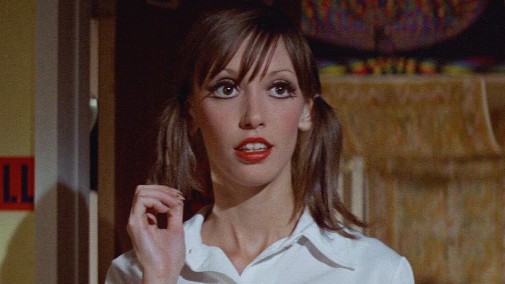 BREWSTER MCCLOUD (1970) Robert Altman
BREWSTER MCCLOUD (1970) Robert Altman
At an event honoring those fallen in NASA's Apollo project, Shelley Duvall was modeling a bathing suit when she met a wannabee artist who'd soon be the first of many serious boyfriends and fiancés. By 1970, the couple was living at his parents' house, trying to save enough money to move out, with Duvall acting as girlfriend and part-time agent. The situation led her to throw a party doing double duty as an artwork exhibit, looking for interested buyers that never materialized. However, some crewmembers from the Brewster McCloud set were in attendance, dazzled by the flower-like hostess they convinced to meet with their film's director and producer later that week.
Shelley Duvall didn't win her first role through the traditional audition process but rather through a passionate sales pitch always focused on those damned artworks. In fact, the young woman who had never stepped outside of Texas didn't see herself as a potential actress. She felt awkward, a loner, more business-oriented than necessarily artistic. Yet, in her own words: "I got tired of arguing, and thought maybe I am an actress. They told me to come, and I simply got on a plane and did it. I was swept away." She was 20, new in Hollywood with a five-year three-picture contract courtesy of Robert Altman's string-pulling.
Once called Sparrowlegs by her schoolmates – another nickname- Duvall was ideal for the anarchic cosmos of Brewster McCloud, a picture obsessed with making connections, often broken and twisted, between humankind and the avian world. The birdlike waif plays an important part, written for her on the spot, deflowering the titular character before ratting him out to the authorities. One year later, she was a discontent mail-order bride in McCabe & Mrs. Miller, another supporting role that asked little more of her than merely existing as her eccentric self in front of Altman's camera.
 THIEVES LIKE US (1974) Robert Altman
THIEVES LIKE US (1974) Robert Altman
Thankfully, she took to the auteur's methodology of few takes and much improvisation like a fish to water, becoming a dependable member within his troupe of regular players. Altman thought she was able "to swing all sides of the pendulum: charming, silly, sophisticated, pathetic – even beautiful." He didn't, however, consider her a remarkable performer. Not yet, at least. Such praise would come with their third movie together, 1974's Thieves Like Us, where the gangster picture model of Bonnie & Clyde was stripped of coolness to reveal the languid rhythms of a lost world, the pathetic humanity of piteous figures, all alone in the world.
Stringy-haired and gangly gracious, Duvall is the picture's beating heart, articulating a delicate romance with Keith Carradine bound to end in sorrow. The actress seems ethereal as Keechie while also grounding herself in the picture's observational naturalism, a paradox that never feels fractious. Her commitment to the part was such that the actress started smoking, catching the habit. Over the years, the vice turned her chirp hoarse, voice made gravely and oh-so-different from what it was in Altman's 1930s-set drama. At long last, all this was enough to impress the director, who told her she was a great actress.
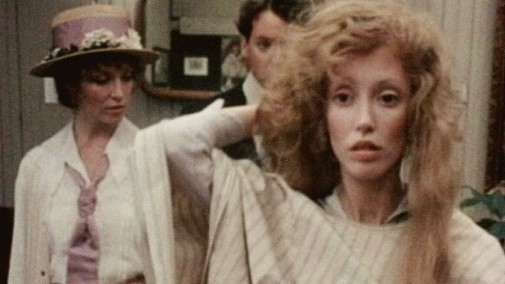 BERNICE BOBS HER HAIR (1976) Joan Micklin Silver
BERNICE BOBS HER HAIR (1976) Joan Micklin Silver
"That was a very, very emotional moment for me. I guess it gave me the confidence to think I could go out and work for other directors as well." – said Duvall in a 1977 interview. In the same article, she'd describe her approach to acting, repudiating notions of fame-seeking and seeing her coterie of screen creations as an opportunity to give the viewers a point of identification. Duvall embodied women with whom audiences could recognize the silly things in life, as well as the more sobering stuff. "We take ourselves very seriously, but there is always a little frailty. We all make mistakes, have little accidents."
Sadly, opportunities to spread her wings outside Altman's little world were few and far between. Maybe her looks were to blame, with contemporary press eager to decry Duvall as an odd duck in the industry, even calling her grotesque. Still, her best performances often came through directors able to see beyond traditional standards of glamour and mass appeal, ready to weaponize the thespian's broken-doll beauty. Hester Street director Joan Micklin Silver did that in the made-for-TV Bernice Bobs Her Hair, perhaps the best filmed adaptation of F. Scott Fitzgerald's literary works. If you're a Shelley Duvall fan, it's required viewing, and it's all on Youtube - check it out!
In the same year, Duvall flew to New York, where she shot her supporting role for Woody Allen's Annie Hall. It's a memorable, if tiny, performance, though the process behind it frustrated the actress. She wanted to read the entire script, but Allen only provided limited selections, prompting musings about writing her own material. Shelley Duvall went as far as buying the rights to Tom Robbins' Even Cowgirls Get the Blues, adapting it into a movie script she was sadly unable to sell. One studio plainly told her it was too quirky even after she toned it down. But of course, there was no time for immediate professional frustration when the greatest success yet was just around the corner.
 3 WOMEN (1977) Robert Altman
3 WOMEN (1977) Robert Altman
After Thieves Like Us, Altman started giving Duvall roles of increased substance, culminating in 3 Women, for which she'd win the Cannes Film Festival Best Actress prize. It was the closest she ever came to Oscar gold, though the nomination never materialized, and it's in the pantheon of her best acting work. The last passages of the film, when dream curdles into nightmare, avant-garde abstraction shifting to horror, were especially impressive to one Stanley Kubrick. He admired Duvall's on-camera crying, particularly her tearful discombobulation, and arranged a meeting in which he gifted her a copy of Stephen King's The Shining. Kubrick had found his Wendy.
Between 3 Women and the start of the future horror classic's England-bound shooting, Duvall briefly considered retirement from show business altogether. She studied psychoanalysis for a little while, going as far as turning down some of Altman's offers, which put a slight damper on their friendship and artistic partnership. Though she didn't continue her path toward a new profession, these studies turned out to be great tools for strengthening her thespian endeavors. In other words, they were acting lessons of a sort. She'd need it all for The Shining, a tortuous project that suffered delays and a grueling schedule, consequence of Kubrick's penchant for multiple takes and an unfortunate set-destroying fire.
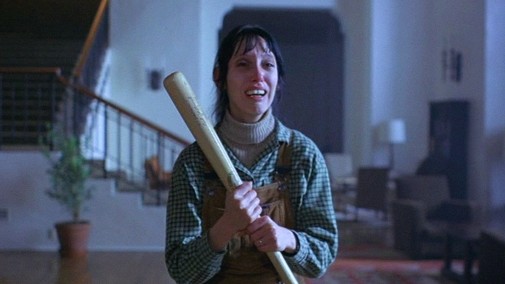 THE SHINING (1980) Stanley Kubrick
THE SHINING (1980) Stanley Kubrick
Behind the scenes stories have turned into legend, occluding the truth behind a palimpsest of conflicting accounts and media exaggeration. Though she compared the experience to how veterans felt about Vietnam, Duvall also has words of admiration for her director. When asked about Kubrick's famed cruelty for a 2021 Hollywood Reporter profile, she said, "He was very warm and friendly to me." The shoot was taxing, but "He spent a lot of time with Jack and me. He just wanted to sit down and talk for hours while the crew waited. And the crew would say, 'Stanley, we have about 60 people waiting.' But it was very important work."
I won't go into more detail since relitigating Shining-related trauma is beyond pointless at this point. People putatively advocating in the actress' name tend to ignore her words, reducing her achievement to exploitation, infantilizing her, and shamelessly ignoring everything she did after leaving the Overlook. Let's leave it at this – Shelley Duvall's performance is a landmark of horror cinema, a miracle that would have earned her an Academy Award in an ideal world. Moreover, Kubrick's methodology was tough but not tougher than his leading lady. No soon was she done with The Shining, Duvall embarked on another epic endeavor – shooting Popeye, her sixth and final Altman film.
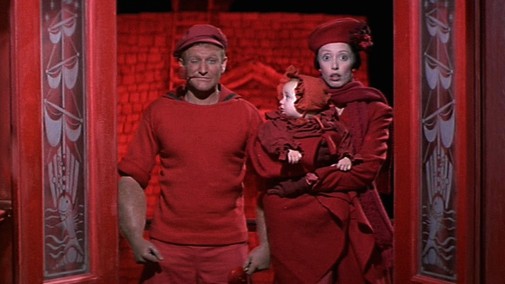 POPEYE (1980) Robert Altman
POPEYE (1980) Robert Altman
Remembered as a disaster, that Altman musical deserves respect for its experimental irreverence, mixing New Hollywood material realism with an honest attempt at replicating the physics of rubber hose animation with flesh and bone actors. As ever, Duvall is in spectacular form, acing the physicality of Olive Oyl while commanding the screen with her frail birdlike song. Where was the Golden Globe nomination, HFPA? Anyway, during the location shoot, the actress found refuge in her illustrated copies of classic fairy tales. Specifically, she couldn't help but marvel over The Frog Prince and wonder what someone like Robin Williams could do with the amphibian character.
That conjecture percolated in the mind, following her through Terry Gilliam's gorgeous Time Bandits and into another phase of a multi-hyphenate career. In 1981, against common industry wisdom, Shelley Duvall ventured into the "virgin territory of show business," cable television, pitching an anthology project to the nascent Showtime. One year later, the first season of Faerie Tale Theater was ready, having sprung from the imagination and efforts of Duvall, now working as a producer. Having learned the hardships and techniques of show business in Altman's sets, she followed a deeply collaborative philosophy that regarded the creative process as inherently collective-minded rather than individualistic.
 FAERIE TALE THEATER: RAPUNZEL (1983) Gilbert Cates
FAERIE TALE THEATER: RAPUNZEL (1983) Gilbert Cates
Moreover, she was intent on securing big names for the cast, bringing legitimacy to the realm of cable, which many still feared as an unstable fad. Though she wasn't yet credited as a casting director, Shelley Duvall took the reins of the projects regarding on-camera talent. Calling every friend, acquaintance, former colleague, or tangential connection, she searched for great thespians willing to try their hand in her Faerie Tale Theater of overt artifice and stylized registers. That's how we get such amazing spectacles like Gena Rowlands as Rapunzel's villain, Vanessa Redgrave tackling Snow White's Evil Queen as if she were Blanche Dubois, Klaus Kinski's Beast to Susan Sarandon's Belle, Mary Steenburgen's Red Riding Hood, Bernadette Peters' Sleeping Beauty, and many more.
Duvall's commitment to quality was felt behind the scenes, too, with her securing established directors like Francis Ford Coppola, who helmed an episode designed by Eiko Ishioka. The Faerie Tale Theater was also an opportunity to foster new talents, including a young Tim Burton, who Duvall first met when playing a suburban mom in the director's original Frankenweenie short. No wonder the series was such a success, spanning seven seasons and birthing various similar projects, including another Showtime-Duvall production - Tall Tales & Legends, which earned the producer her first Primetime Emmy nomination.
Beyond the TV Academy, she was embraced by the Ace Awards, winning eight out of fifteen nominations accrued over a decade. She also won a Peabody Award and joined Jane Fonda in the Home Video Hall of Fame. By the late 80s, Shelley Duvall was musing on cable channels directed exclusively at kids, almost anticipating the birth of the Disney Channel with which she would soon collaborate in Mother Goose Rock 'n' Rhyme. Around this time, the taste for independence also led Duvall to start her own company, Think Entertainment, initially focused on children's programming and soon expanded into more adult material like a remake of Dinner at Eight with Marsha Mason, Lauren Bacall, and Ellen Greene among other luminaries.
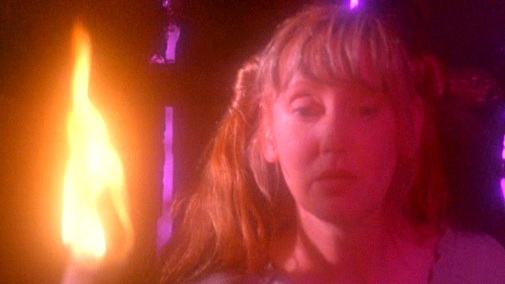 TWILIGHT OF THE ICE NYMPHS (1997) Guy Maddin
TWILIGHT OF THE ICE NYMPHS (1997) Guy Maddin
In 1991, the LA Times characterized her as "the tenacious producer who put cable on the map and breathed new life into children's TV," and that didn't even account for her forays into the recording business, defending freedom of speech against Tipper Gore's anti-rock 'n' roll crusade, and overseeing the making of educational video games. All this left Duvall with little time for acting, but she still participated in projects by interesting auteurs, including Steven Soderbergh's The Underneath, Jane Campion's The Portrait of a Lady, and Guy Maddin's Twilight of the Ice Nymphs. That last one dates to 1997, 18 years after the shoot many say ruined Duvall.
Still, by the dawn of the new millennium, the actress-turned-producer was ready to retire, living with her husband, Dan Gilroy, in California before relocating to her Texan origins. 2002's Manna from Heaven was the last picture shot before all acting work was dried up and abandoned, leaving Duvall to age outside the public's probing gaze. And so it was until a 2016 Dr. Phil interview where a confused Duvall was shown incoherent and paranoid, suffering from mental illness issues that should have never been exploited for entertainment. That cursed program has much blame in the current trend of infantilizing Duvall beyond agency, painting her as a victim and little else.
 Photograph by Eric Ryan Anderson, for THE HOLLYWOOD REPORTER
Photograph by Eric Ryan Anderson, for THE HOLLYWOOD REPORTER
May this lengthy write-up serve to dissuade you of such notions. Please don't let that craven reality TV stunt be the last and most lasting impression you have of Shelley Duvall, and don't allow the shadow of backstage gossip to erase all the tremendous things she achieved in the last two decades of the 20th century. Words can't come close to verbalizing how much I adore this unique artist with butterfly wings for lashes, birdsong turned to gravel, ethereal and terrified like no one else has ever been or will ever be. I can only hope to share that affection with all of you. So, dear reader, how do you feel about Shelley Duvall? What are your favorites among her many works? There's no better way to celebrate her birthday than to spread some well-earned love, so get to it!